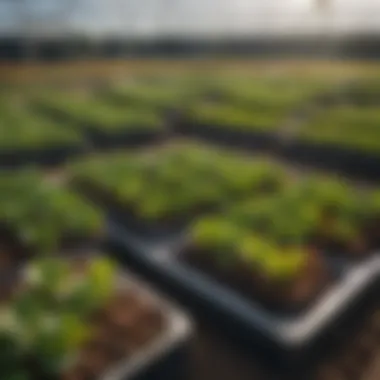128 Cell Plug Flats: A Key Tool in Horticulture


Intro
In the realm of horticulture, the methods and tools employed can significantly affect the outcome of cultivation. One such tool that has gained traction in recent years is the 128 cell plug flat. These trays, specially designed to house young seedlings, provide a multitude of benefits that enhance growth and optimize available space. Often overlooked, they play a crucial role in fostering robust plant development while supporting sustainable practices in agriculture.
This article will explore the underpinnings of 128 cell plug flats, delving into their defining characteristics, the historical backdrop from which they emerged, and the recent innovations that have propelled their popularity. From practical applications to cutting-edge techniques, we will provide a comprehensive examination tailored for farmers and horticultural enthusiasts geared towards enhancing their understanding and application of this vital tool in modern horticulture.
Foreword to Cell Plug Flats
In the world of horticulture, where every seed counts, 128 cell plug flats have emerged as a game changer. These innovative planting systems play a crucial role, not just for commercial growers but also for hobby gardeners wanting to increase their efficiency and yield. They are designed to optimize seedling growth while minimizing space and resource use, which is essential in today’s competitive agricultural landscape.
Definition and Overview
A 128 cell plug flat refers to a tray that contains 128 individual compartments designed for sowing seeds or young plant cuttings. Each compartment, or cell, allows for the aquatic environment of seeds or seedlings, providing them with enough space to grow without being overcrowded. This design supports stronger root systems and healthier plants, which ultimately contribute to higher survival rates upon transplanting.
The versatility of plug flats caters to a variety of plants, ranging from delicate flowers to sturdy vegetables, making them invaluable across numerous horticultural applications.
Historical Development in Horticulture
The use of plug flats isn't something that popped up overnight. The concept has roots that trace back several decades when horticulturalists began to recognize the benefits of specialized propagation techniques. Originally, seedlings were often planted directly into soil or large trays, which led to problems with overcrowding and root entanglement. Enter the plug flat—developed to overcome these hurdles.
As demand for efficient growing methods surged, especially in greenhouse settings, plug flats began to be refined. The 128 cell model is a product of this evolution. Over time, these trays have been manufactured with various materials like biodegradable plastics and foams, reflecting an increased focus on sustainable practices. More importantly, they revolutionized the way plants are propagated, allowing for uniformity and ease in cultivation on a larger scale.
Today, they remain a standard in greenhouses and farms, aiding in the large-scale production of healthy seedlings. With the continuous advance of agricultural technology, the future of plug flats looks bright. They are not just a tool of convenience but are pivotal in ensuring that horticulture stays both productive and sustainable.
Advantages of Using Cell Plug Flats
The use of 128 cell plug flats stands as a cornerstone in modern horticulture, serving multiple purposes that streamline gardening and farming efforts. Their design promotes efficient use of resources, providing growers with a tool that maximizes production while minimizing waste. This section explores the key advantages offered by 128 cell plug flats, which are essential in fostering seedling growth, optimizing space, and facilitating an effective transplanting process.
Enhanced Germination Rates
One of the most compelling benefits of employing 128 cell plug flats is the enhanced germination rates they encourage. The design allows for controlled conditions that are vital for the early stages of plant growth. Each cell provides a microenvironment where seeds can receive the exact moisture and oxygen levels they require to sprout effectively. Unlike traditional soil trays, these plug flats mean less competition among seedlings, reducing stress on emerging plants. This leads to a more uniform growth pattern, bringing a gardener's plan to fruition sooner.
In practice, this means that farmers can achieve a higher percentage of viable seedlings from each batch, significantly boosting their outputs. Beyond just numbers, healthy seedlings grown in these flats typically exhibit robust growth characteristics, leading to a better overall yield when transplanted. This translates not just into higher success rates but also contributes to the economic viability of utilizing plug flats.
Space Efficiency in Cultivation
Modern agriculture demands efficiency, and this is where space efficiency in cultivation through the use of 128 cell plug flats shines. The compact design means that more plants can be cultivated in a smaller footprint, making it a highly valuable asset for urban gardeners or farmers with limited acreage. By fitting more seedlings in the same amount of space, growers maximize their productivity without expanding their land usage.
"Every square foot counts in the garden; maximizing that space with plug flats can resolve what many perceive as a real estate issue for plants."
This space efficiency not only allows for greater yields but also simplifies management tasks. With seedlings organized neatly, it becomes straightforward to monitor growth conditions or assess nutrient needs. It is especially beneficial for those who may be working in vertical farms or enclosed greenhouse systems where real estate is at a premium.
Streamlined Transplanting Process
The streamlined transplanting process that 128 cell plug flats offer is a significant factor in their appeal. When it comes time to move seedlings into their permanent spots, the sturdy design prevents root disturbance. Each plug maintains its soil structure, reducing the shock that comes with transplanting. With roots more intact, plants can quickly acclimate to new environments, thus resuming their growth with minimal delay.
Furthermore, handling these plugs is a breeze—no need to wrestle with large clumps of soil, just lift, plant, and water. This efficiency is crucial, especially during peak planting seasons when time is of the essence. Farmers report reduced labor costs thanks to the simplified transplanting, allowing them to focus their resources on other essential tasks.
In summary, the advantages of using 128 cell plug flats intertwine efficiency, enhanced plant health, and economic benefits, offering a holistic approach to modern agriculture. By leveraging these flats, horticulturists can not only improve their operational practices but also cultivate a more sustainable and productive environment.
Material Composition of Plug Flats
The material composition of 128 cell plug flats is a vital topic within horticulture as it influences everything from seedling health to the efficiency of the entire planting process. Different materials used in the making of these plug flats can determine how well plants thrive, how easily they can be transplanted, and how effectively they absorb nutrients and moisture. Understanding these materials helps growers select the most suitable option based on their specific needs and environmental conditions.
Common Materials Used for Production


A range of materials are commonly used in the production of 128 cell plug flats. These include:
- Plastic: One of the most prevalent materials due to its lightweight and durable nature, plastic plug flats are easy to manufacture and can come in various sizes and thicknesses. They often have drainage holes which is essential for preventing waterlogging.
- Biodegradable Materials: With increasing awareness of sustainability, many manufacturers are now producing plug flats from biodegradable substances like coconut coir or wood pulp. These options break down naturally over time, reducing waste and promoting soil health.
- Foam: Some plug flats are made from foam, which provides excellent aeration and moisture retention. This material allows for a more controlled environment for young seedlings.
- Composite Materials: A blend of various materials can also be found. These often combine the benefits of plastic with the characteristics of biodegradable elements, creating a versatile tool that meets the needs of eco-conscious growers.
The choice of material can significantly affect not just the logistics of planting, but also the growth rates and resilience of the plants themselves.
Impact of Material on Plant Health
The impact of material composition on plant health can be quite profound. Here are key considerations regarding how different materials influence growth:
- Water Retention and Drainage: The right material should balance water retention with proper drainage. Excess water can suffocate roots while insufficient moisture can stunt growth. For example, plastic may retain more moisture, which is beneficial in dry conditions, but can pose a risk of overwatering without adequate drainage holes.
- Aeration: Materials like foam or biodegradable materials often allow for better airflow to the roots. This aeration is crucial in preventing diseases that thrive in dense, moist conditions, thereby promoting healthier root systems.
- Nutrient Supply: Some materials might interact with soil or fertilizers in ways that can either enhance or inhibit nutrient availability to the plants. For instance, biodegradable options might release beneficial organic matter as they decompose, enriching the soil.
- Root Development: The structure and rigidity of the material affect how roots develop. Thicker plastics might restrict root growth, while softer materials may allow for better expansion.
"Choosing the right plug flat material can mean the difference between flourishing plants and struggling seedlings."
In the quest for optimal horticultural practices, recognizing the significance of material composition in plug flats is crucial in aiding both novice gardeners and professional cultivators alike.
Choosing the Right Plug Flat for Your Needs
Choosing the correct plug flat can make or break the success of your horticultural endeavor. With countless options available, particularly with 128 cell plug flats, understanding how to select the right one for your specific needs is crucial. Each type of plug flat serves a distinct purpose, tailored for various crops and growth contexts. A wise choice can lead to robust seedlings and maximized growth conditions, while a poor selection may result in stunted development or wasted resources.
Factors to Consider
When picking a plug flat, several key factors must be weighed:
- Plant Type: Different plants have varying root structures and developmental needs. For instance, delicate herbs may thrive in more shallow plugs, while sturdy vegetables like tomatoes might need deeper cells.
- Growth Cycle: If you're working with a plant that has a fast growth cycle, such as lettuce, opt for plugs that facilitate quick transplanting. On the other hand, slower-growing crops, like perennials, may benefit from a longer nurturing phase within more spacious cells.
- Climate Conditions: Consider your local climate. For example, in wetter climates, a plug flat with ample drainage will help prevent root rot, whereas more solidly packed flats may warn against drying out in drier regions.
- Nutrient Needs: Some plants, like peppers, require more nutrients in their early stages. Plug flats with a dedicated nutrient mix can support optimal early growth.
- Installation Space: How much physical space you have will affect your choice too. Some plug flats take up more room than others, which could be an issue for both greenhouse and personal gardening setups.
Ultimately, pondering over these factors will steer you toward a plug flat that aligns with your objectives, whether you're cultivating crops for personal enjoyment or professional production.
Comparative Analysis with Other Sizes
Examining how 128 cell plug flats stack up against other sizes is invaluable for understanding their practical applications. Generally, plug flats come in various configurations, including 32, 50, and 72 cell variants, each tailored to distinct purposes:
- 32 Cell Plugs: Ideal for larger plants, these cells give ample room for root expansion but might be wasteful for smaller seedlings.
- 50 Cell Plugs: A versatile option, these can accommodate various plants from flowering crops to herbs, though still leave some room for inefficiency in fit.
- 72 Cell Plugs: Closer to 128 cells, these flats are excellent for extensive crops but may require careful monitoring to ensure there is no overcrowding.
- 128 Cell Plugs: This size maximizes space while providing sufficient nutrients and drainage for each seedling. They weigh a perfect balance between density and health of the plants.
Examining the practical implications of these sizes reveals that while 128 cell options excel in space efficiency and early-stage care, other sizes have their merits depending on what one is planting. Ultimately, this analysis empowers growers, enabling them to make a savvy choice based on what works best for their specific needs, thereby enhancing their horticultural practices.
"The right tool for the right job is an adage that proves itself true in every gardening endeavor, especially in the world of plug flats."
By considering both the factors influencing your choice and comparing available options, you can place yourself in the best position to foster thriving plants and efficient production.
Application Techniques for Cell Plug Flats
Understanding how to effectively use 128 cell plug flats is essential for optimizing their benefits in horticulture. The techniques applied in planting, watering, and managing nutrition can significantly influence plant health and crop productivity. By mastering these application techniques, horticulturists can ensure that their efforts are not just meeting the basics but are heading toward unparalleled success in their planting endeavors.
Best Practices for Planting
When it comes to planting in 128 cell plug flats, preparation and timing are two crucial elements. First off, selecting high-quality seeds suited for the specific environment is non-negotiable.
- Careful Seed Selection: Choose seeds that not only thrive in your climate but also have visible viability. This step paves the way for better germination rates.
- Sowing Depth: This is another factor that can’t be overlooked. Different seeds have different requirements; some might need a shallower depth while others demand more coverage. Follow the seed packet recommendations as closely as possible.
- Spacing Considerations: Although each cell accommodates a single seed, consider future growth. Allow adequate room for budding roots to ensure that plants aren’t competing for nutrients right from the get-go.
Planting at the right time is just as important. In many cases, starting seedlings indoors then transitioning them to plug flats when the time is right can lead to stronger plants. This process also allows for initial root establishment, preparing them for the outdoor environment.
Watering and Nutrition Management


Watering and nutrition management is where many amateurs tend to falter. It’s essential to strike a balance; too much water could drown the seedlings, while too little could starve them.
- Moisture Awareness: Always check the moisture level in the soil before watering. The top inch or so should feel slightly dry while the deeper parts remain moist. This practice avoids overwatering which can lead to root rot, a nightmare for any horticulturist.
- Use of Fertilizers: Start with diluted fertilizers specifically suited for seedlings. Early nutrient application should be gentle yet consistent; seedlings are particularly sensitive to strong chemicals.
- Foliar Feeding Techniques: Sometimes, spraying diluted fertilizer on the leaves can enhance nutrient absorption. Be cautious though - using this method during harsh sunlight could lead to leaf burn.
Investing time into these techniques will undoubtedly yield higher success rates. Keeping a close watch on planting zones, moisture levels, and nutritional needs leads to not just survival but vigorous growth of your plants.
"Effective application techniques for 128 cell plug flats can turn your tedious gardening into a fruitful harvest, enabling you to make the most of every seed sown"
Implementing these best practices will create a solid foundation for your horticultural journey. Each aspect of planting and nurturing within these plug flats is aimed at ensuring that your plants do not just grow, but flourish.
Impact on Crop Production
The significance of 128 cell plug flats in crop production isn’t merely a talking point; it’s fundamentally tied to how efficiently and effectively crops can be grown and harvested. They play a pivotal role in maximizing the potential yields of both commercial and personal gardening projects. With each cell ideally tailored to nurture young plants, the farming method allows for meticulous resource allocation that speaks directly to the productivity of modern horticulture.
Yield Optimization
When we discuss yield optimization, we step into a realm where planning meets execution. The 128 cell configurations of plug flats help farmers achieve remarkable performance by ensuring optimal spacing and resource sharing among seedlings. This close confinement does not stifle growth; instead, it promotes competition that can lead to healthier, more vigorous plants. Imagine the difference made by having well-established roots before moving them out into soil that may not be as nutrient-rich.
- Enhanced Root Development: A tight setup like this encourages roots to seek out resources more effectively. seedlings develop stronger, more extensive systems that thrive when transferred to garden beds or larger pots.
- Accelerated Growth Rates: Sharing nutrients happens within the cells themselves. Consequently, seedlings often reach market-ready sizes quicker than those grown in traditional trays or open gardens.
- Consistency in Size: When every seedling is nurtured in identical conditions, size uniformity becomes more achievable. This consistency is crucial for both farmers aiming for market-grade produce and hobbyists looking for aesthetic appeal in their gardens.
Reducing Labor Costs
Another noteworthy consideration is the impact of these plug flats on labor costs. Traditionally, transplanting involves a considerable time investment. From sowing seeds to nurturing them until they are robust enough for permanent placement, it can quickly become labor-intensive. However, with 128 cell plug flats, this process can turn into a streamlined operation.
- Simplified Transplanting: A plug flat allows for a more convenient extraction of plugs. This ease of movement significantly cuts down on the time spent during this phase.
- Minimized Risk of Damage: The design facilitates careful handling, reducing the chances of damaging fragile seedlings during the transfer process.
- Labor Efficiency: With less time spent on transplanting and maintenance, labor resources can be reallocated to other pressing areas of farm management. For instance, while a smaller crew focuses on transplanting, others can dedicate efforts to weeding or pest management—leading to a net gain in productivity.
"Optimizing labor through efficient planting techniques can change the tide for many small and large farms alike."
In summary, the careful integration of 128 cell plug flats into crop production systems not only ramps up yield output but also cuts costs drastically. For farmers and horticulturists, making these plug flats part of their growing strategy could mean smoother operations and healthier plant life, which ultimately lead to more fruitful harvests.
Sustainable Practices with Plug Flats
The horticultural industry is steadily shifting towards sustainable practices. Incorporating 128 cell plug flats into modern cultivation not only enhances efficiency but also aligns with broader environmental goals. Given the pressing challenges of climate change and resource conservation, understanding sustainable practices with plug flats becomes increasingly essential.
Environmental Benefits
Using 128 cell plug flats contributes significantly to a healthier environment. First off, they promote biodiversity by allowing for a variety of seedlings to grow in a confined space, optimizing the use of available resources. This sort of approach not only maximizes productivity but also encourages the proliferation of beneficial organisms in the soil. The high density of sowing can lead to healthier plant communities, decreasing the need for pesticides as plants can naturally resist diseases when grown together.
Moreover, the construction of these flats often includes biodegradable materials, reducing dependency on petroleum-based plastics. When they reach the end of their lifecycle, these flats can decompose rather than persist in landfills, thus mitigating plastic pollution. This factor is crucial considering the statistics that reveal how millions of tons of plastic waste choke our planet every year.
"Every small step towards sustainability counts, especially in agriculture, where the impact can ripple through the food chain."
Minimizing Waste
One of the notable advantages of using 128 cell plug flats is their ability to minimize waste in several ways. First up, the precise control over seed planting means less surplus. Gone are the days of over-sowing seeds and then tossing those that never sprout. With plug flats, each cell gets just the right amount of soil and moisture, making for a more economical planting process.
Secondly, these plug flats can also be reused multiple times before they require replacement. Simply cleaning them after each use ensures that they can maintain their integrity for future plantings. In addition, the efficient design allows for optimal space usage. This means less overall resource consumption because growers can fit more seedlings into a smaller area without compromising their growth.
For farmers and horticulturalists looking to enhance sustainability in their practices, 128 cell plug flats offer a robust solution that benefits both the ecosystem and one’s bottom line. With these flats, reducing waste is not just an afterthought but a core component of the cultivation process.
Challenges and Limitations
While 128 cell plug flats bring a myriad of benefits to modern horticulture, it’s crucial to recognize the challenges and limitations that can come with their use. Assessing these aspects not only helps in understanding the complete picture but also informs practitioners in making more efficient decisions that can affect the success of their cultivation efforts.


Potential Drawbacks of Plug Flats
Using plug flats can indeed streamline the production process, but they also harbor some drawbacks worth understanding. One significant concern is the risk of root bound plants. If seedlings are left in plug flats for too long, their roots can encircle the plug, leading to stunted growth once transplanted. This issue can arise quickly, particularly with fast-growing species that don't reflect their readiness by height alone. Management of this timing is vital;
- Regular monitoring of root development is essential to ensure timely transplanting.
- A failure to address this can limit crop productivity without proper planning.
Another factor to consider is the cost associated with purchasing high-quality plug flats. While the initial investment can result in long-term gains, some growers might struggle to justify the expense, especially in a tight financial landscape. Cheaper alternatives exist, but they may not perform as reliably, which could ultimately offset any savings through lower performance or higher losses.
"A penny saved is a penny earned, but not if those pennies come at the cost of a lost crop."
Management of Soil Conditions
Soil conditions are equally crucial for the successful use of 128 cell plug flats. These small cells can dry out faster than larger pots, so proper moisture management is a key concern. If the substrate used is too coarse, water retention will be inadequate, resulting in quick dehydration of seedlings. Alternatively, overly dense media can lead to poor aeration and root rot.
- Regular Soil Testing: It's essential to periodically check pH, nutrient levels, and moisture content to provide the best growing conditions.
- Water Management: Developing a watering schedule tailored specifically to the needs of the seedlings often results in healthier plants. Over or under-watering can lead to significant repercussions in terms of growth and viability.
Also, using 128 cell plug flats may require frequent adjustments in fertilization strategies. The compact nature of these cells means that nutrients can be depleted rapidly as the seedlings begin to establish themselves. Therefore, tailoring the nutrient supply in conjunction with vigilant soil management can maximize the potential of these flats.
Future Trends in Horticulture Technology
In the fast-evolving world of horticulture, the future is bright, with trends that promise to enhance productivity, sustainability, and efficiency. The role of 128 cell plug flats cannot be overlooked as these innovations play a pivotal role in enhancing traditional practices. Keeping up with these emerging technologies offers horticulturists a chance to stay ahead of the curve and improve their growing techniques.
Emerging Technologies Related to Plug Flats
The integration of 128 cell plug flats in horticulture is increasingly being supported by cutting-edge technologies. One area of development is the use of smart sensors. These devices can monitor various factors such as moisture levels, temperature, and nutrition in real-time. This technology allows growers to optimize conditions for seedlings, ensuring they receive just the right amount of care.
Another exciting advancement includes automated transplanting systems that are designed to work efficiently with plug flats. By leveraging robotics, these systems can handle plug flats with precision, transplanting seedlings into various environments quickly and accurately. Not only does this save labor, but it also reduces handling stress on young plants, promoting better health and growth rates.
Additionally, the concept of vertical farming is gaining traction. This approach utilizes 128 cell plug flats stacked in layers, maximizing space and allowing for improved ventilation and access to light. Combining these flats with hydroponic or aeroponic systems means that plants can grow faster and healthier, all while conserving water.
"Innovation in horticulture isn’t just about what you grow, but how you grow it."
Sustainability continues to be a buzzword, and novel materials for plug flats are emerging that are biodegradable or made from recycled products. These innovations align with the industry's goal of minimizing environmental impact, making it easier for growers to adopt practices that benefit the planet.
Integration with Precision Agriculture
Precision agriculture marries technology with traditional farming methods, allowing for more personalized care of crops. This integration is set to revolutionize how plug flats are used in horticulture. Through geospatial mapping, farmers can analyze their fields and devise tailored strategies for irrigation, nutrient delivery, and pest management. This data-driven approach means that each 128 cell plug flat can be treated based on its unique needs, ensuring optimal growth conditions throughout the cultivation process.
Utilizing drones for monitoring is another game-changer. Drones can survey vast areas of land quickly, capturing images that highlight plant health and soil conditions. Coupling this information with plug flats helps farmers recognize potential problems in the early stages, allowing preemptive action to be taken.
Furthermore, the use of artificial intelligence can enhance decision-making in horticulture. AI can analyze the data collected from various sources to suggest optimal growing strategies, predict yield outcomes, and even forecast market trends. When tied to a system of plug flats, this capability provides farmers with insights that can significantly boost productivity and profitability.
End
In this article, we've taken a close look at the role of 128 cell plug flats and underscored their importance in contemporary horticulture. As we've seen, these plug flats are not merely tools; they are dynamic instruments that facilitate growth in a variety of ways. One of the standout benefits lies in their capacity to enhance seedling health through efficient space utilization and effective nutrient management.
Summary of Key Points
To recap some of the essential insights discussed:
- Enhanced Germination Rates: The design of 128 cell plug flats allows for optimal conditions for seedling development, resulting in improved germination rates which are crucial for successful crop production.
- Space Efficiency: With the compact nature of these flats, users can maximize their growing area, making them ideal for both large-scale operations and urban gardening setups.
- Streamlined Transplanting: The consistent cell size not only eases the transplanting process but also reduces the stress trana plants face during this crucial transition, potentially leading to better recovery and growth.
- Sustainability Focus: Using these plug flats aligns with sustainable practices by minimizing material waste and promoting efficient water usage.
- Challenges to Consider: While 128 cell flats offer numerous advantages, it's vital to be mindful of potential drawbacks, such as those concerning soil health and the management of specific growing conditions.
Call for Further Research
The journey doesn't end here. As agriculture moves forward, there's a pressing need for more focused research on several fronts:
- Long-term Impacts: Investigate the long-term effects of using 128 cell plug flats on both soil health and plant development, ensuring that benefits can be sustained over time.
- Material Innovation: Exploring new materials that might improve plant health or reduce environmental impacts could pave the way for better plug flats—something that could greatly benefit growers.
- Technological Integration: How can emerging technologies enhance the functionality and efficiency of plug flats in conjunction with precision agriculture techniques?
Further studies in these areas can provide deeper insights that refine these important tools for horticulturists and contribute positively to sustainable agricultural practices.















